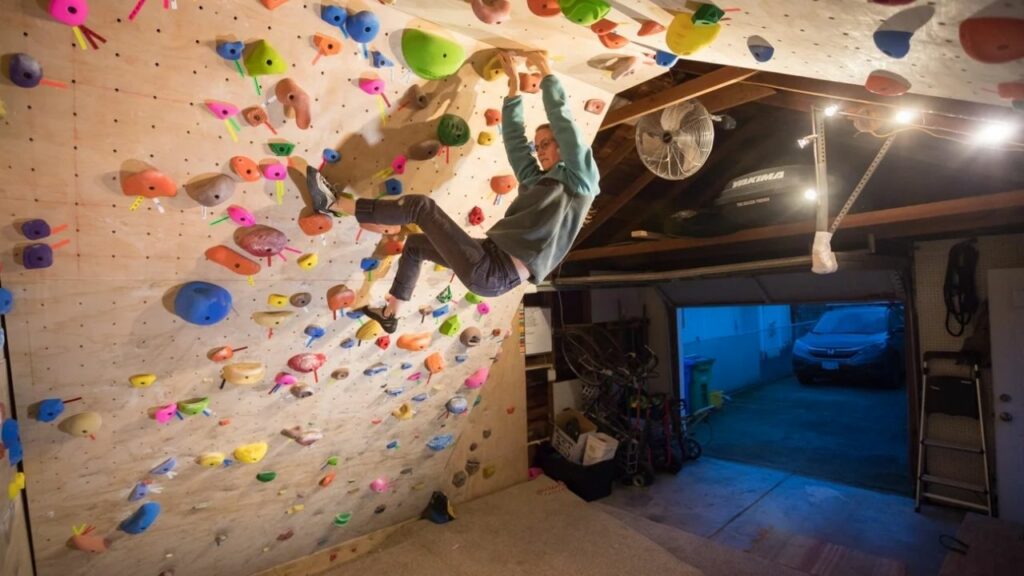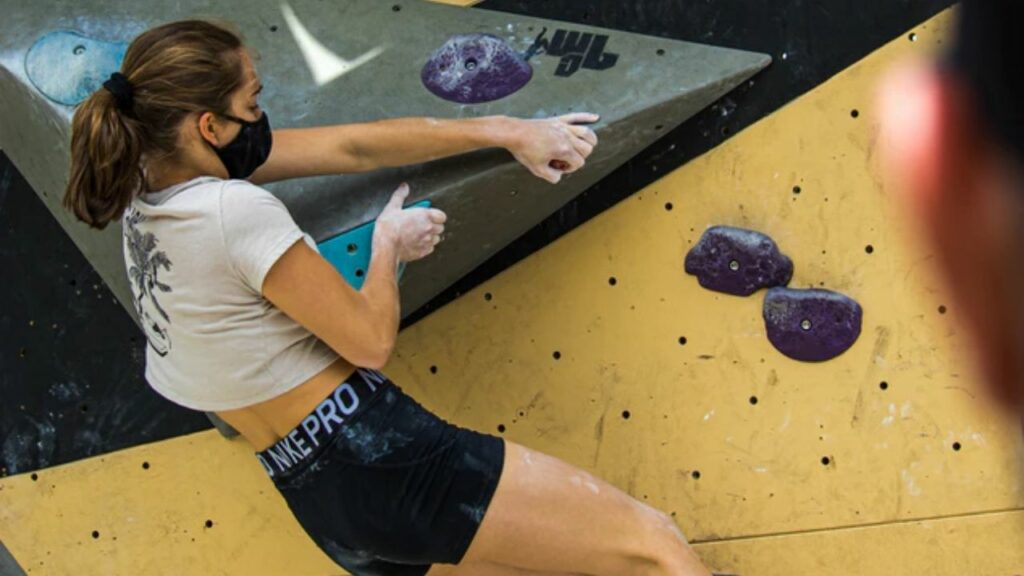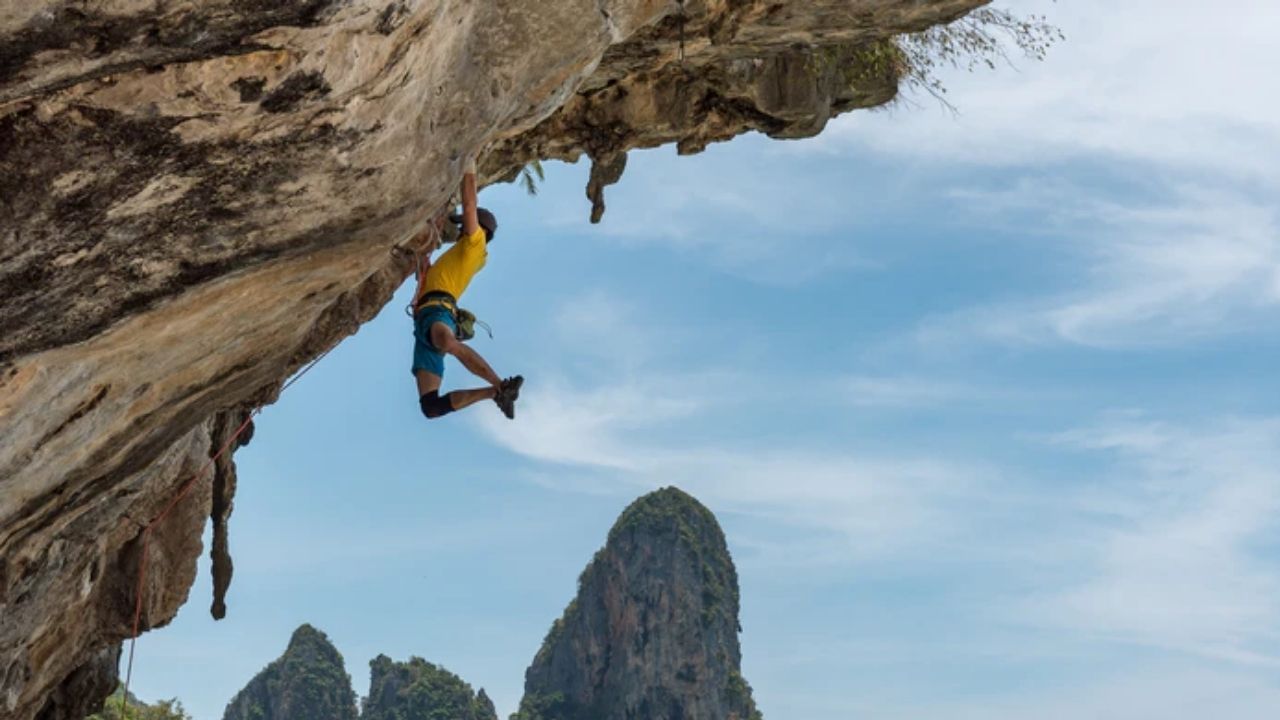When I first started climbing, I was in awe of dyno-ing . Surely, I thought, only a pro or prodigy could do one of those crazy dynamic moves, right? Boy, was I wrong.
In my defense, the dyno dilemma is one of the most common pain points in bouldering and rock climbing. Not just for rookies but also experienced climbers. Committing to that kind of powerful motion can just seem really, really effin’ hard.
Truth is, you CAN totally crush the good ole’ dyno. There may be dozens of ways to mess up, but only a few to do them right.
A proper dyno move (aka, Deadpoint or dynamic movement) differs from most climbing techniques. Generally, you need to create a balance between some of the building blocks of climbing. But you’ll need all of them to make a dyno happen: power, speed, precision, experience, and posture.
If you don’t jump high enough, you fall. If you don’t jump from a stable position, you slip and fall. If you don’t have the power, speed, and accuracy to grab the hold and nullify your body’s momentum, you fall.
So, then, what’s the secret to mastering climbing dynos?
What is considered a dyno in climbing?
A dynamic climbing move, or simply dyno, is a dynamic jump involving power and skill to reach a hold that would otherwise be out of reach.
That said, you don’t have to wait till you clear a V6/V8 or 10a+ climbing route. You can (and should) immediately begin laying the groundwork for dyno moves when you reach the intermediate status.
In my dictionary, an intermediate climber is someone who has etched the climbing fundamentals into their muscle memory. And have some high-level techniques under their belt they’re particularly good at doing.
Consider that as the bare minimum to qualify for learning dyno moves.
How to learn a dyno move in climbing?
There are many “exercises” to learn a dyno move. You can probably find a dozen within two minutes with Google Search. I personally prefer Rachel Carr’s (Psychi) guide. In the beginning, you want to practice on a reachable hold by stretching your hand.
Step 1: Step onto the wall. Bend down in a squat-like position with your hands stretched. Use your hands as levers to rise up and touch the next hold. Remember to keep your hips close to the wall for stability before bending and after rising.
Keep going up and down several times to get the timing and posture right. Don’t worry about falling. If you’re going up to get the hips closer to the wall, your body’s momentum will keep you from falling while switching holds.

Step 2: Next, practice with the desired hold out of hand’s reach. Get onto the wall and bend down. Now, go up while shifting your weight onto the front foot, like climbing stairs or stepping up.
Of course, you can’t secure it right now. The real goal is to touch the hold (or the wall at a certain height) and jump down on the mat. Ensure that you’re hips are moving closer to the wall as you go up.
Step 3: It’s an advanced version of step 2. Instead of shifting your weight, try jumping off the back foot as if launching yourself. This helps you reach higher and learn to jump.
The most important thing is to secure the hold properly. Simply touching or grabbing it in an unstable position won’t keep you on the wall.
Step 4: Just repeat steps 1-3 on an inclined / hanging wall instead of a vertical one. This further builds your strength, technique, and experience. Increase the inclination of the wall ever so slightly as you progress.
Step 5: Practice!
Keep practicing your newly learned dyno on different routes to master the move. Don’t start any higher than the first hold off the route because you’re just practicing. Climbing to the middle point of the quarter mark of the route just to practice jumping is plain stupid.
A good learning method is to practice simple routes that can be cleared without a dyno. You can skip one or two holds to practice your jump and maintain balance. This way, you can learn how to do vertical, and sideway dyno jumps in various wall inclinations.
Don’t forget the following during practice:
- Launch yourself from the back foot.
- Keep your hips closer to the wall
- No jumping unless you’re in a stable position.
- Don’t be afraid to take both hands off the wall if the distance is too big. Trust in your leap.
- Trust your training and go for it. Spending too much time dilly-dallying will tire you and ruin a perfectly stable position.
How to do Dyno in climbing?
Dyno isn’t a single move; at its core, you’re jumping to grab a hold at its core. So, you can perform a dyno in more ways than one – straight upwards, sideways, etc. What you need is the experience and technique to identify a potential dyno.
1. Identify a potential dyno move.
You must identify the next hold and calculate the best possible move. Jumping is your only option if you can’t reach the next hold by stretching.
Next, gauge how difficult the dyno is based on the shape of the next hold, the jumping distance, and the inclination of the wall. Only jump if you have a high probability of grabbing the hold.
The ability to perfectly gauge a dyno’s difficulty compared to your current physical capabilities will only come from experience. Don’t worry about it right now.

2. Visualize the jump and prepare accordingly.
Before jumping, you need to do two things accurately. Visualize the jump to calculate the best possible trajectory. Think of the angle, position, and power you’ll need to make the correct jump.
I know it’s hard to imagine yourself doing such calculations on the go. But it’s not too different than catching a ball thrown at you or even walking. Human brains are pretty good at calculating trajectory and adjusting motor movements. They just need to be honed for specific purposes, and that’s what the training was for.
Finally, adjust your position to find a launch point that’s both stable and easy to jump from.
3. Make it happen. And don’t lose control.
Enough thinking; you’re ready now. Let’s make the jump.
A successful dyno has three important steps – launch, grab, and control. Grab the intended hold as quickly as possible after jumping.
Don’t think it’s over yet. You gotta immediately control your body’s momentum to hang on to the hold. Find a stable position after stopping the momentum.
A Pro Climber’s Tips to Dyno-ing Beginners
1. You’re gonna fail. And it’s okay.
It wouldn’t be an understatement to say that dyno-ing is one of the hardest things to learn in climbing. Don’t be afraid to fail or fall off the wall.
2. Focus on technique, not success.
Some of the easier dyno moves (the early ones) can be easily done by modifying your posture but don’t do that. It’ll be impossible to do proper dyno-ing with incorrect posture. Feed the correct method into your muscle memory thoroughly.
3. Use your arms to aim, your legs are for jumping.
Dynos are done from your legs, not arms – but I guess that’s true for 99% of climbing maneuvers.
Additionally, your legs should aim straight upward during the jump. Use your arms to aim and position yourself. Jumping from an angle can affect the trajectory.

4. Grab the hold harder than you normally would.
You can’t call your dyno successful unless you have gotten into a stable position after grabbing the hold. Simply, touching and falling down won’t do. Grabbing is just the second act. If you celebrate too quickly, you’ll fall down.
Finally, you should study a concept called the “flow state” It isn’t an exact science but something worth knowing, especially for intense techniques like dyno moves.
When to use dynos and when to avoid them?
Generally, only advanced climbers should try dyno moves on an outdoor route. It’s highly unsafe because you neither have an extended mat to fall on nor a well-defined hold setup for the dyno. In comparison, indoor climbing gyms have special routes that favor dynos.
Additionally, you should also avoid dyno moves for non-generic holds that need to be captured in a specific way, such as cracks. And if you’re doing a dyno outdoors, avoid sharp rocks. Even if you nail the most perfect dyno – done with speed, style, and dynamic efficiency – you can still end up cutting your hands. It just brings so much power.
Does that mean you basically can’t do dynos at most places? Well, no, you can. But if you get the dyno-ing technique and experience down, you’ll be able to clear challenging routes faster while expending less energy. Cheers to that.

